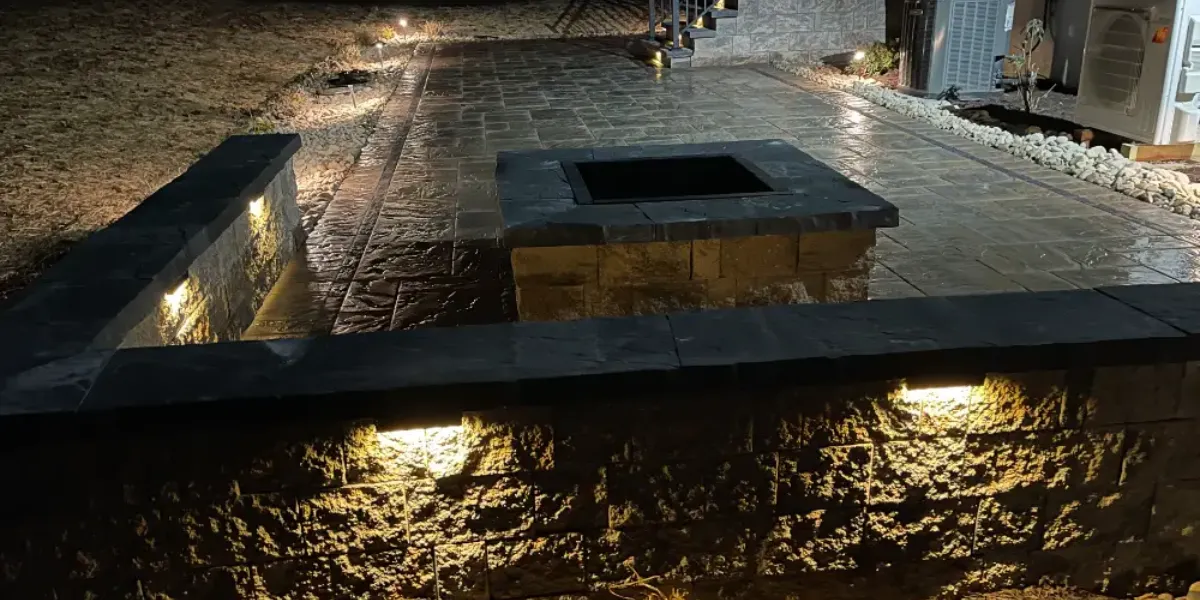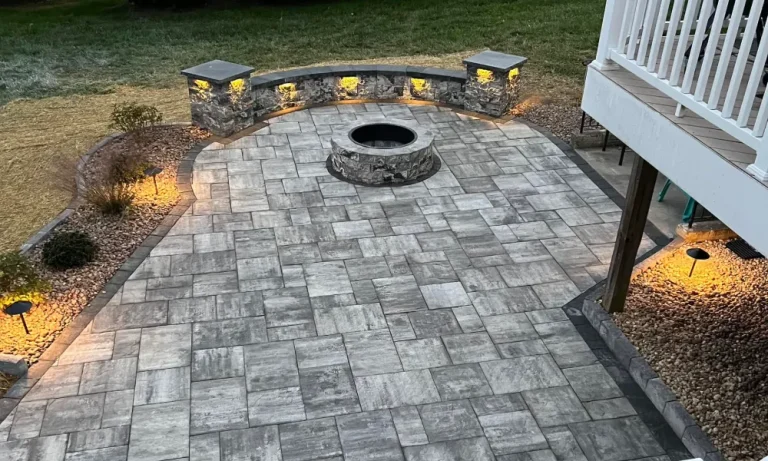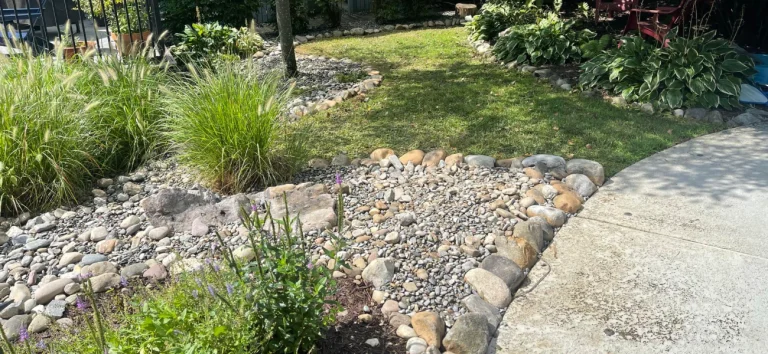Can I Install Landscape Lighting Without Running New Wires?
If you want to enhance your home’s curb appeal or increase backyard safety but are hesitant about tearing up your yard to install wiring, you’re not alone. Many homeowners across Bel Air and the surrounding Harford County area ask us the same thing: Can I add landscape lighting without running new wires?
The good news is—yes, in many cases, you can. Thanks to advances in low-voltage and wireless lighting technology, there are now several effective ways to light up your landscape without complex electrical work. In this post, we’ll walk you through your options and help you understand when a wire-free approach makes sense—and when professional installation may still be the better choice.
The challenges of traditional wired landscape lighting
Wired landscape lighting systems are known for their performance and reliability. They’re often the go-to choice for homeowners who want full control over outdoor lighting—complete with timers, dimmers, and multiple lighting zones. But while these systems offer long-term benefits, they’re not always the most practical or efficient option for every home.
Installation can be disruptive
Installing a wired lighting system typically requires trenching through your lawn, garden beds, or hardscaped areas to run conduit and electrical wiring. This can be especially frustrating if you’ve already invested in landscaping, newly planted beds, or a finished paver patio.
-
- Lawn and plant beds may need to be dug up
- Hardscaping may need to be cut or lifted
- Irrigation systems may be disturbed in the process
For many homeowners, the idea of tearing up a finished outdoor space just to add lighting is a dealbreaker.
It may require permits and licensed electrical work
In Maryland, wired lighting often falls under electrical code requirements. That means hiring a licensed electrician, pulling permits, and possibly coordinating with your local municipality—especially if the system connects directly to your home’s power panel.
-
- Increases the project timeline
- Adds to the total cost
- Can create scheduling delays if multiple contractors are involved
Upfront costs are higher
Between labor, wiring, transformers, trenching, and fixture installation, traditional systems can be expensive to install—particularly in larger yards or more complex landscapes.
-
- Material costs are higher
- Labor is more intensive
- More planning and design work is required
This isn’t always ideal if you’re just looking to illuminate a walkway or highlight a few garden features.
Repairs and future changes can be complicated
Once the wiring is in the ground, making changes later can be a challenge. If a wire becomes damaged—or if you decide to expand or modify your lighting layout—you may need to dig everything up again to access the connections.
-
- Troubleshooting is more time-consuming
- Changes often require new trenching
- Repairs can damage surrounding landscaping
Why many homeowners look for low-impact alternatives
Because of these drawbacks, many homeowners throughout Bel Air, Churchville, and Fallston are turning to wire-free and low-voltage options that deliver reliable performance without the disruption. Whether you're lighting a front walkway, a backyard patio, or decorative garden features, there are plenty of modern solutions that don’t require full-scale excavation or rewiring.
Wire-free and low-voltage lighting options
If you’re looking to upgrade your landscape lighting without running new electrical wiring through your yard, there are excellent alternatives available. Homeowners throughout Harford County—especially in areas like Bel Air, Fallston, and Jarrettsville—often ask us about solutions that minimize disruption while still enhancing outdoor spaces.
Below are three of the most popular and practical options that don’t require extensive electrical work or trenching:
1. Solar-powered lights
Solar landscape lighting is one of the easiest and most accessible options for homeowners. Each fixture has its own built-in solar panel, battery, and light sensor. During the day, the sun charges the battery, and at dusk, the light automatically turns on.
Best suited for:
-
-
- Walkways and garden paths
- Accent lighting around shrubs, flower beds, or driveways
- Homeowners seeking a low-maintenance, eco-friendly option
-
Advantages:
-
-
- Completely wireless – No wiring or electrical connections required
- Easy DIY installation – Simply stake the fixture into the ground
- Environmentally friendly – Powered by renewable solar energy
- Low operating cost – No impact on your electricity bill
-
Limitations:
-
-
- Performance depends on sun exposure – Shaded yards or cloudy climates can reduce reliability
- Limited brightness – Not ideal for large spaces or security lighting
- Basic functionality only – Lacks dimming or control features
-
Pro tip: Solar lighting works best when used as part of a layered lighting design. You can combine it with low-voltage fixtures for more consistent lighting in key areas like patios or stairways.
2. Battery-powered landscape lights
Battery-operated lights are another wireless option that offers greater flexibility in placement. Many models now come with motion sensors, dimmers, and smart controls that sync with mobile apps or home automation systems.
Best suited for:
-
-
- Decks and patios
- Seasonal displays or temporary installations
- Areas where solar isn’t effective due to shade or low sunlight
-
Advantages:
-
-
- No wiring or solar dependency – Works in any location, shaded or not
- Portable and repositionable – Great for renters or changing layouts
- Smart home compatibility – Many modern options include remote control or app-based features
-
Limitations:
-
-
- Requires battery maintenance – Batteries need replacing or recharging
- Lower brightness and runtime – Not as powerful as hardwired or low-voltage systems
- May not scale well – Less efficient for lighting large yards or full outdoor living spaces
-
Pro tip: Battery lights are great for accent lighting or highlighting specific features, like garden art or outdoor seating, but they may not be a full replacement for wired systems in larger landscapes.
3. Low-voltage plug-and-play lighting
For homeowners who want the reliability of a wired system without the hassle of deep trenching or complex installation, low-voltage plug-and-play systems strike the perfect balance. These systems use a transformer that plugs into an existing outdoor GFCI outlet and steps down your home’s power to a safe 12-volt current. Fixtures then connect to the transformer via simple low-voltage cabling, which can often be tucked beneath mulch or hidden behind landscaping.
Best suited for:
-
-
- Lighting around patios, walkways, pergolas, and retaining walls
- Mid- to large-sized properties needing more brightness or control
- Homeowners who want long-lasting, professional-grade lighting with minimal disruption
-
Advantages:
-
-
- Safe and energy-efficient – Uses low voltage, ideal for residential settings
- Consistent and bright – Suitable for areas that need stronger illumination
- Compatible with timers and smart controllers – Easily programmable and automation-friendly
- Minimal disruption – Wires can often be installed without full trenching
-
Limitations:
-
-
- Requires access to an exterior outlet – Limited to areas within reach of power
- Still involves some cable management – May need shallow trenching for clean results
- Transformer limits – Only powers a certain number of fixtures per unit
-
Pro tip: This option is especially popular when installed alongside other landscape features like paver patios, seat walls, or pathways—all services we provide at Harvest Outdoor Living.
Whether you’re interested in solar lighting for your garden paths, battery-powered lights for flexibility, or a low-voltage system that mimics a professionally wired setup without the heavy construction, there’s a solution that fits your needs and budget.
Let our team help you evaluate your property and goals to find the best combination of performance, aesthetics, and practicality.
When to consider professional lighting installation
While wireless lighting has come a long way, there are situations where a professionally installed low-voltage wired system still provides the best results. If your property has large areas to illuminate, steep slopes, limited sun exposure, or you want full control over dimming, zoning, or color temperature, a custom-designed system may be the better investment.
At Harvest Outdoor Living, we specialize in designing and installing outdoor lighting systems that enhance safety, showcase landscape features, and improve night-time ambiance—all while considering drainage, hardscaping, and overall landscape design. In some cases, we use a hybrid approach, combining wired lighting near the home with solar or battery fixtures in farther zones.
Real example: Solar and low-voltage lighting combo in Churchville
A recent client in Churchville wanted to light up their paver walkway and backyard seating area without disturbing their mature garden beds. Our team installed soft solar path lights along the garden perimeter and integrated a low-voltage transformer to power more focused lighting under the seat walls and steps of the patio. The result was a warm, welcoming outdoor space—without the need for major electrical work or disruption to the landscape.
Proudly serving Harford County and surrounding areas
Harvest Outdoor Living designs and installs professional landscape lighting systems across Harford County, including:
-
- Bel Air
- Abingdon
- Aberdeen
- Churchville
- Fallston
- Forest Hill
- Havre De Grace
- Jarrettsville
- Perry Hall
- White Marsh
Whether you’re looking for solar upgrades, battery-powered options, or a complete lighting overhaul, we have the experience and design expertise to bring your vision to life.
Light up your landscape—without the hassle
Want to add outdoor lighting but not sure where to start? Let our experts evaluate your property and recommend the best solution—whether that’s wireless fixtures, low-voltage options, or a custom-installed system. Call Harvest Outdoor Living today or request an estimate online.
We proudly serve Bel Air and the surrounding Harford County area with landscape lighting, hardscaping, drainage solutions, and full outdoor living design.



